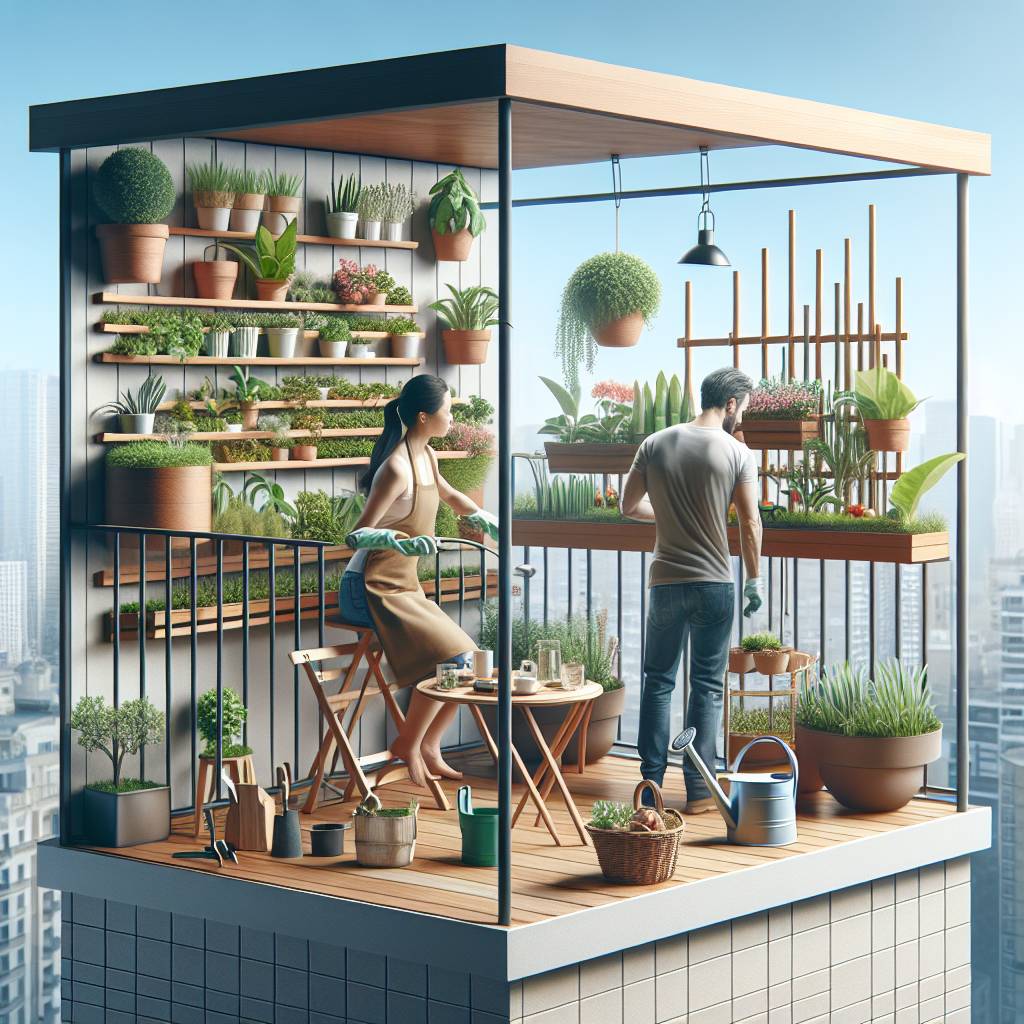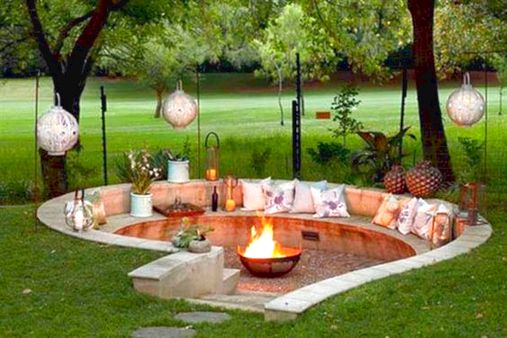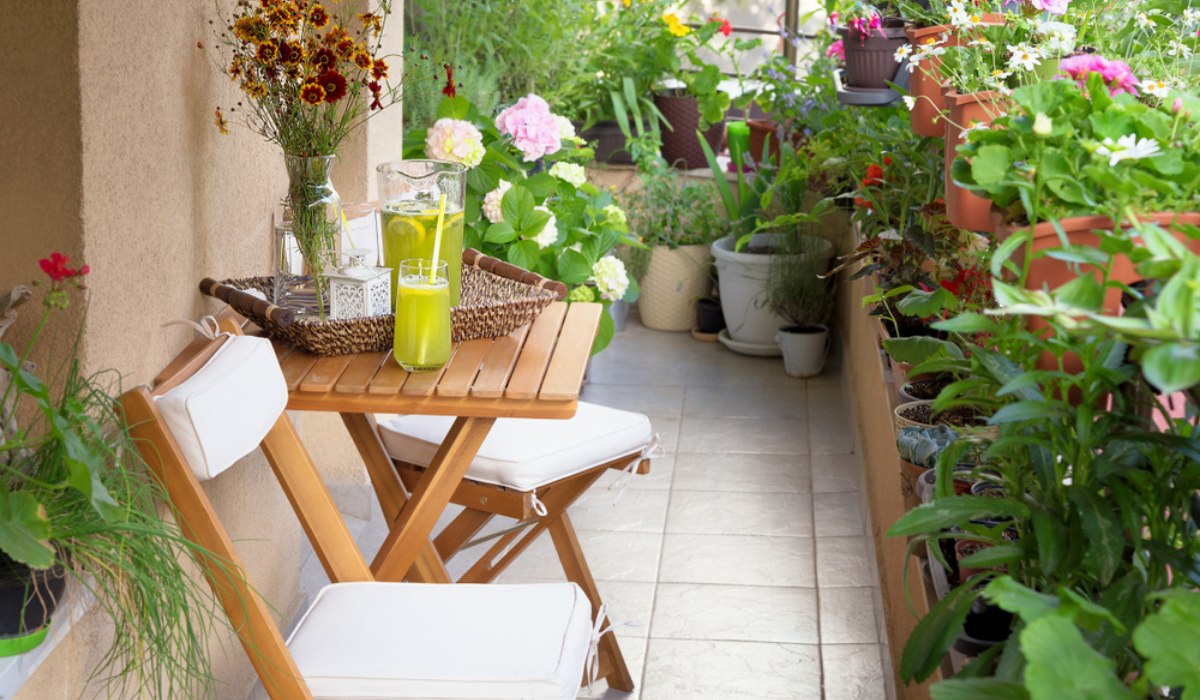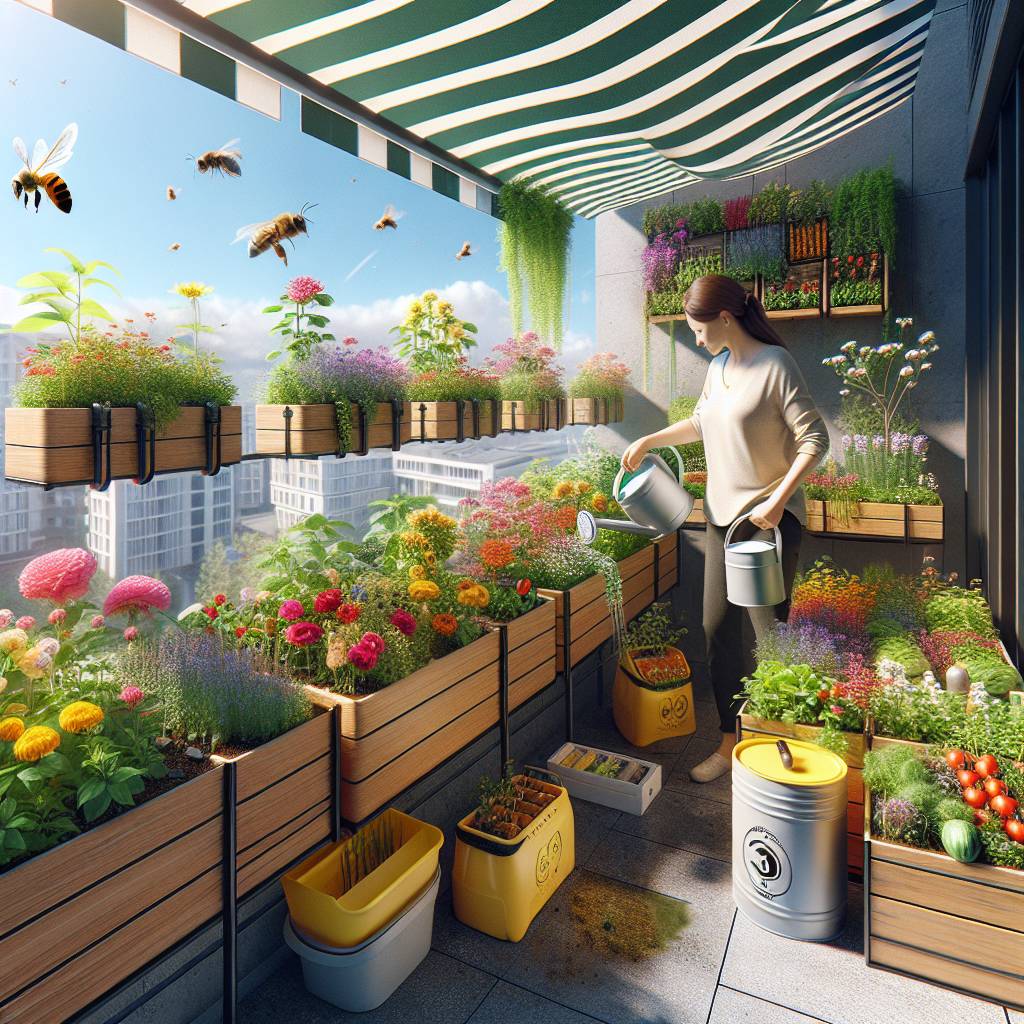Dreaming of a lush garden but confined to a balcony? Renters, rejoice! You don’t need acres of land to cultivate your green haven. This guide will equip you with practical tips and creative solutions tailored specifically for balcony gardening in rental spaces, terrace, rooftop, and area. Say goodbye to the misconception that renting equals limited gardening opportunities. We’ll explore space-saving techniques, container options, low-maintenance plant varieties, and ways to personalize your vertical oasis without upsetting your landlord. No longer restricted by concrete barriers, you can transform your humble balcony into an urban jungle bursting with life and color.
Key Takeaways
- Seek permission from your landlord or building management before starting a balcony garden to avoid potential issues.
- Choose plants that are suitable for pot growth and consider vertical gardening to maximize space in a small balcony.
- When selecting containers, prioritize lightweight, durable, and appropriately sized pots for your plants.
- Map out the sunlight direction on your balcony to ensure that your plants receive the required amount of sunlight for healthy growth.
- Implement a regular watering and fertilizing schedule to maintain the health and productivity of your balcony garden.
- Regular maintenance, including pruning, weeding, and pest control, is essential for a thriving and beautiful balcony garden.
Essential Considerations for Balcony Gardening
Assessing Balcony Size and Weight Capacity
Understanding the size and weight capacity of your balcony is crucial. Measure the available space to determine how many plants you can accommodate without overcrowding. Consider the weight limit your balcony can support. For instance, if you live in an apartment building, there might be restrictions on the amount of weight that can be placed on the balcony.
It’s essential to choose lightweight pots and containers that won’t exceed your balcony’s weight capacity. Opt for plastic or resin planters instead of heavy ceramic ones. These materials are durable, weather-resistant, and won’t add unnecessary strain to your balcony structure.
Choosing the Right Pots and Containers
Selecting suitable pots and containers is imperative when establishing a balcony garden. Look for options that provide proper drainage to prevent waterlogging while ensuring they fit within the confines of your outdoor space. Hanging baskets, railing planters, window boxes, and vertical wall planters are excellent choices for maximizing limited space.
Consider using adjustable railing planters that can be easily attached to different parts of your balcony railing without causing damage. These allow you to grow plants vertically while keeping walkways clear—a perfect solution for small balconies with minimal floor space.
Understanding the Microclimate of Your Balcony
Understanding the microclimate of your balcony is vital as it directly impacts which plants will thrive in this environment. Take note of how much sunlight reaches different areas throughout the day—some spots may receive full sun exposure while others remain shaded.
For example, if your balcony receives several hours of direct sunlight daily, herbs like basil, rosemary, or thyme would flourish in such conditions. On the other hand, if certain areas only receive indirect light or shade most of the time due to nearby buildings or structures blocking sunlight, opt for shade-tolerant plants like ferns or begonias.
Guidelines for Renters on Permission to Plant
Checking the Rental Agreement
Before starting a balcony garden, renters should carefully review their rental agreement to check for any clauses or restrictions related to gardening. Some landlords may have specific rules about what can be placed on the balcony or may prohibit certain activities that could damage the property. It’s essential to understand these terms before proceeding with any gardening plans.
It is crucial for renters to ensure that they are not violating their rental agreement by engaging in balcony gardening. If there are any uncertainties regarding the terms, it’s advisable to seek clarification from the landlord or property management.
Seeking Permission and Restoration Offer
Once renters have thoroughly reviewed their rental agreement, they should consider seeking permission from their landlord or property management before initiating any balcony gardening projects. This proactive approach demonstrates respect for the property owner’s rules and regulations while also fostering open communication.
When requesting permission, renters can offer assurances of restoring the balcony space back to its original condition upon moving out. This could involve providing a detailed plan outlining how they will ensure that no permanent alterations are made during the course of their balcony gardening activities.
For instance:
- Renters might propose using portable planters instead of making permanent installations.
- They could also offer to cover all expenses associated with returning the balcony area back to its original state when they vacate the premises.
Selecting Suitable Plants for Pot Growth in a Small Space
Compact Plant Options
Selecting the right plants is crucial. Opt for compact plants that thrive in containers, such as cherry tomatoes, peppers, and dwarf varieties of vegetables like carrots and lettuce. These plants take up minimal space while still providing a bountiful harvest.
Consider herbs like basil, chives, and mint; they not only add flavor to your meals but also flourish in confined spaces. Compact flowers such as petunias, pansies, and marigolds bring color and vibrancy to your balcony without overwhelming the limited room you have available.
Shallow Root Systems
Researching plants with shallow root systems is essential when choosing greenery for pot growth. This ensures that the roots won’t become cramped or restricted by the confines of their container. For instance, strawberries are an excellent choice due to their shallow roots and ability to thrive in pots.
Maximizing Vertical Space in Balcony Gardening
Utilizing Hanging Baskets
Making the most of the vertical space is crucial. One effective way to do this is by using hanging baskets. These are perfect for growing trailing plants like petunias, fuchsias, or even cherry tomatoes if they’re properly supported.
Hanging baskets not only save precious floor space but also add a beautiful visual element to your outdoor living area. They can be easily attached to the balcony railing or ceiling, allowing you to grow an array of plants without taking up any ground space.
Another benefit of utilizing hanging baskets is that they can be moved around easily, enabling you to experiment with different plant placements and create an ever-changing display on your balcony.
Wall-Mounted Planters and Trellises
In addition to hanging baskets, consider installing wall-mounted planters and trellises on your balcony. This allows you to grow a variety of plants vertically against the wall, maximizing every inch of available space.
Vertical gardens created using wall-mounted planters not only provide greenery but also act as natural air purifiers while adding aesthetic appeal to your outdoor living space. You can grow herbs, flowers, or even small vegetables such as lettuce or spinach in these planters.
Moreover, incorporating trellises into your balcony garden design opens up opportunities for growing climbing plants like ivy or morning glories. These plants naturally thrive when given something vertical to climb on and can transform a plain wall into a lush green backdrop within no time.
Creating a Tiered Garden
To further optimize limited outdoor living space, consider creating a tiered garden using shelves or plant stands on your terrace or balcony. This approach enables you to accommodate more pots and containers while keeping them organized in an aesthetically pleasing manner.
Potting Techniques and Container Selection for Small Gardens
Lightweight Containers
Using small pots or lightweight containers is essential. These are easy to move around, especially if you live in a rented space where you might need to relocate at some point. Opt for containers made from materials like plastic, fiberglass, or resin as they are lighter than ceramic or concrete options.
Proper Drainage
To ensure the health of your balcony garden plants, it’s crucial to provide proper drainage. This can be achieved by adding a layer of gravel or pebbles at the bottom of your pots before adding soil and planting. The gravel helps prevent waterlogging and root rot by allowing excess water to drain away from the roots.
Sufficient Depth
Choosing containers with sufficient depth is vital for balcony gardening success. When selecting baskets or pots, consider the varieties of plants you want to grow and ensure that the container provides enough room for their roots to spread out and grow deeply. For example, herbs like rosemary require deeper pots compared to shallow-rooted annual flowers.
In addition:
- Lightweight containers make it easier to rearrange your garden layout.
- Gravel or pebbles aid in preventing water accumulation at the bottom of pots.
- Deep containers accommodate various plant types such as vegetables, herbs, and flowering plants.
Understanding Sunlight Direction and Mapping Out Space
Observing Sunlight Throughout the Day
Balcony gardening for renters requires a keen understanding of sunlight patterns. Spend a day observing how the sun moves across your balcony. Take note of areas that receive direct sunlight, those with partial shade, and spots that remain in full shade. This will help you determine which plants can thrive in each area based on their sunlight requirements.
It’s essential to consider the angle at which sunlight hits your space, as this affects the intensity and duration of exposure. Different plants have varying needsSo knowing these details will guide your plant selection process.
Planning Plant Placement for Optimal Sunlight Exposure
Once you’ve mapped out the different light conditions on your balcony, plan where to position your plants accordingly. For example, herbs like basil and rosemary thrive in full sun, while ferns prefer shadier spots. By strategically placing your containers based on their specific sunlight needs, you’ll create an environment where all your plants can flourish.
Consider using vertical space creatively by hanging baskets or installing shelves to accommodate more plants without crowding limited floor space. This way, you can make use of every nook and cranny that receives adequate sunlight throughout the day.
Watering and Fertilizer Maintenance in Balcony Gardens
Establishing a Watering Routine
Establishing a watering routine for your balcony garden is crucial to ensure the well-being of your plants. Consider the specific needs of each plant species, as some may require more water than others. Take into account the weather conditions, adjusting your watering schedule during hot, dry periods or rainy seasons. For example, succulents thrive with infrequent watering due to their ability to store water, while leafy greens may need more frequent hydration.
Efficient Watering Systems Consider using self-watering containers or drip irrigation systems for efficient watering in your balcony garden. Self-watering containers have built-in reservoirs that supply moisture to the soil as needed, reducing the frequency of manual watering. Drip irrigation systems provide a controlled flow of water directly to the plant roots, minimizing wastage and ensuring consistent hydration.
Applying Organic Fertilizers
Regularly applying organic fertilizers is essential for promoting healthy growth in balcony gardens. Unlike synthetic alternatives, organic fertilizers release nutrients slowly over time without harming beneficial microorganisms in the soil. This promotes sustainable growth and helps maintain soil fertility over an extended period.
Choosing Suitable Fertilizers When selecting fertilizer products for your balcony garden, opt for those specifically formulated for container plants or vegetables if you’re growing edibles. Look for balanced formulas with equal N-P-K (nitrogen-phosphorus-potassium) ratios suitable for overall plant health.
Tips for Creating a Beautiful and Productive Vegetable Garden
Choosing Vegetables
Selecting the right vegetables is crucial. Opt for compact varieties that thrive in containers, such as cherry tomatoes or mini bell peppers. These vegetables not only fit well in limited space but also produce an abundant harvest.
For vining vegetables like cucumbers or beans, providing adequate support is essential. Consider using trellises, stakes, or cages to help these plants grow upward rather than sprawling across your balcony. This ensures they receive proper air circulation and sunlight while maximizing your available space.
Companion Planting Techniques
Implementing companion planting techniques can significantly benefit your balcony garden. For instance, pairing basil with tomatoes not only enhances the flavor of the tomatoes but also helps repel pests that commonly affect tomato plants. Similarly, growing marigolds alongside your vegetable crops can deter harmful insects and attract pollinators.
In addition to pest control benefits, companion planting maximizes space by combining different plants with complementary growth habits. For example, tall-growing corn provides shade for sun-sensitive lettuce when planted together.
Balcony gardening offers a great way to cultivate fresh produce even in urban settings where outdoor space may be limited. By choosing suitable vegetables and implementing smart support systems and companion planting techniques, renters can successfully grow their own food on balconies.
Maintenance Tips for a Thriving Balcony Garden
Pruning and Deadheading Plants
Pruning and deadheading are essential tasks to ensure your balcony garden stays healthy. By regularly cutting back overgrown or dead branches, you encourage new growth and maintain the overall health of your plants. For instance, if you notice any wilting leaves or withered flowers, simply trim them off using gardening shears. This will promote fresh blooms and foliage, keeping your garden looking vibrant.
Focus on removing any damaged or diseased parts of the plant. This not only improves its appearance but also prevents diseases from spreading to other areas of the plant. By deadheading spent flowers – those that have wilted or dried up – you redirect energy towards producing new blooms rather than seed production.
Pest and Disease Monitoring
Regularly inspecting your plants for pests and signs of disease is crucial for maintaining a thriving balcony garden. Keep an eye out for common pests such as aphids, spider mites, and whiteflies which can wreak havoc on your plants if left unchecked. If you spot any pests, consider using natural remedies like neem oil spray or insecticidal soap to keep them at bay without harming beneficial insects.
Moreover, be vigilant about identifying early signs of plant diseases such as powdery mildew or leaf spot. Address these issues promptly by trimming affected areas or using appropriate fungicides to prevent further spread within your garden.
Rotating Plant Positions
Rotating the positions of your potted plants is vital for ensuring they receive balanced sunlight exposure while preventing overcrowding in specific spots on your balcony. For example, if one side of your balcony receives more sunlight than the other throughout the day, periodically move sun-loving plants from shady areas into the light so they can thrive evenly.
Final Remarks
Congratulations! You’ve now mastered the essentials of balcony gardening for renters. By understanding the crucial considerations, guidelines for plant permissions, plant selection, vertical space utilization, potting techniques, sunlight mapping, watering and fertilizer maintenance, vegetable gardening tips, and garden maintenance, you’re well-equipped to create a thriving green oasis in your limited space. Now it’s time to put your newfound knowledge into action and transform your balcony into a lush and vibrant garden. Start by assessing your balcony’s potential, selecting the right plants, and implementing the best practices you’ve learned. Remember, with a little creativity and dedication, even the smallest balcony can become a flourishing garden paradise.
Frequently Asked Questions
Is balcony gardening suitable for renters?
Yes, balcony gardening is perfect for renters as it allows you to create a beautiful garden without making permanent changes to the property. You can easily move your plants when you relocate.
How can I get permission from my landlord to start a balcony garden?
Approach your landlord with a well-thought-out plan that includes details about the types of plants you want to grow and how you’ll maintain the space. Highlight that it will enhance the property’s appeal.
What are some suitable plants for pot growth in a small space?
Herbs like basil, thyme, and mint; compact vegetables such as cherry tomatoes and peppers; and flowers like petunias and pansies thrive in pots on balconies due to their adaptability to confined spaces.
How can I maximize vertical space in my balcony garden?
Utilize hanging planters, wall-mounted shelves, or trellises to make use of vertical space. This not only adds visual interest but also expands planting area without taking up valuable floor space.
What are some maintenance tips for ensuring a thriving balcony garden?
Regularly check soil moisture levels, prune dead foliage, watch out for pests, and provide appropriate fertilization. Rotate plant locations periodically so they all receive adequate sunlight.






